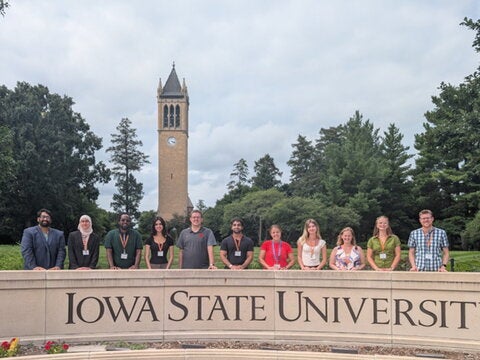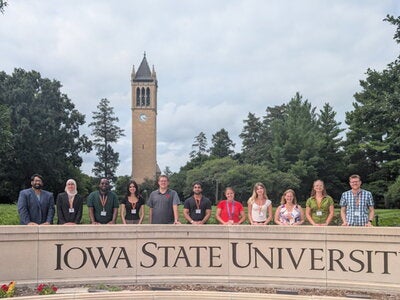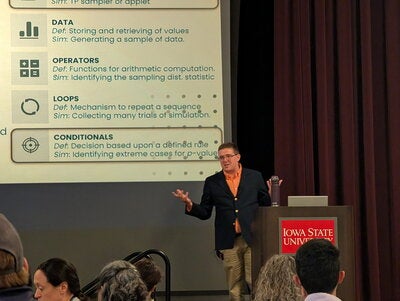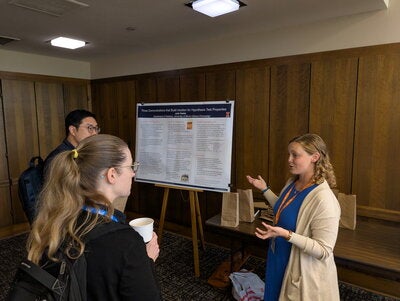

The United States Conference on Teaching Statistics (USCOTS)—organized by the Consortium for the Advancement of Undergraduate Statistics Education (CAUSE)—returned this summer to Iowa State University with the theme "Useful Models." Since 2005, USCOTS has brought together teachers and researchers to exchange ideas through keynote addresses, interactive breakout sessions, poster presentations, technology demonstrations, and lightning talks. This year's program, held from July 17th to 19th, also included a Research Satellite and a Liberal Arts Symposium, with pre-conference workshops preceding the main events.
Illinois was represented by six educators whose work spans undergraduate, graduate, and secondary education: statistics professors Vimal Rao, Kelly Findley, Kit Clement, Christopher Kinson, and Julie Deeke, as well as Emily Buhnerkempe, a teaching associate at University Laboratory High School. Their contributions ranged from invited talks to workshops and research presentations:
- Vimal Rao — Opening Session Invited Talk (YouTube link); Breakout Session: Essentials of the scholarship of teaching statistics
- Kelly Findley — Research Satellite Poster: Developing Data Agency: A Longitudinal Study of Statistics Majors’ Journeys Into the Discipline; Closing Session Invited Talk (YouTube link)
- Chris Kinson — Research Satellite Poster: Developing Data Agency: A Longitudinal Study of Statistics Majors’ Journeys Into the Discipline
- Kit Clement — Research Satellite Invited Talk: Exploring the Impact of Applet-Based and Modeling-Based Simulation Curricula On the Ways Students Interpret R Code and Conceptualize Inference When Conducting Simulations
- Julie Deeke — Poster Presentation: Three Demonstrations that Build Intuition for Hypothesis Test Properties
- Emily Buhnerkempe — Breakout Session: Teaching probability through play: A high school carnival project including community outreach; Closing Session Invited Talk (YouTube link)
Opening with momentum: Rao on innovation, rigor, and student impact
Reflecting on the meeting's climate, Vimal Rao emphasized the mix of research energy and practical classroom tools: "This conference always brings together insightful education researchers and statistics educators. This year in particular I thought the sessions featured innovative tools for statistical practice and teaching, which generated many research ideas."
Rao's USCOTS contributions bookended the conference. In the opening session, he challenged attendees to amplify diverse ideas to strengthen interdisciplinary innovation. In his workshop, " Essentials of the Scholarship of Teaching Statistics," he introduced scholars new to education research to core elements of rigorous study design and qualitative/assessment principles. The highlight, however, was watching Illinois undergraduates thrive: "This is the first time I've taken undergrad students to the conference, and they did such a great job, I had colleagues coming up to me asking permission to recruit them for grad school! I'm so proud of the students, and that pride is by far the most valuable takeaway I could have possibly imagined." (Illinois student perspective)
Rao noted that the group is already channeling this momentum back to campus, with the intention of solidifying Illinois as a national leader in teaching statistics and undergraduate statistics education research.
Human-centered analysis in the AI era: Findley and Kinson on data agency
Generative AI surfaced repeatedly across sessions, not as a replacement for learning, but as a provocation to clarify what's distinctively human in statistical work. Kelly Findley summarized it this way: "There were a lot of discussions on teaching statistics and statistical programming while being cognizant of generative AI tools. With so many skills now being automated and the job market around tech changing so quickly, educators are now having to question the uniquely human-centered skills and influences that are important for statistics and data science."
Findley's research follows how students develop data agency by seeing data analysis as a sequence of informed human decisions rather than a purely mechanical exercise. "Good data analysis is not free of human bias, but should instead be very transparent about human influence." His plans after USCOTS include revisiting coding assignments: "I'm revisiting a lot of my coding assignments. One goal I have is to figure out how I might actually encourage students to thoughtfully use generative AI tools to expand their horizons of what they can code. Another goal is to consider how to diversify my questions so that students are encouraged to draw from their own perspectives and curiosities…" He also left inspired by Beth Chance's [California Polytechnic University in San Luis Obispo] framing to foreground "modeling" earlier and more intentionally across the curriculum.
His co-author Chris Kinson echoed Findley's sentiments: "The most valuable takeaway for me is that the statistics discipline has come a long way and is now in a prime time to reflect on our role as educators and embrace the future with AI in our tool box." Kinson's teaching centers on innovative, technology-enhanced methods, adding, "I envision AI being fully embraced in my courses and throughout the discipline to expand what students are learning and their ability to apply course concepts."
Their joint poster, "Developing Data Agency: A Longitudinal Study of Statistics Majors' Journeys into the Discipline," examines how students' identities and practices evolve throughout the major. As Kinson put it: "In a way, we are researching how students develop their statistics and data science identities as they matriculate through the statistics major, while their identities shape and inform the statistics discipline." He's now eager to adapt a framework-based research protocol and "incorporating AI as a part of the investigations in how students form ideas in creativity and collaboration."
From applets to R: Clement on simulation, agency, and transfer

Kit Clement focused on how students transition from GUI-based simulation tools to reading and reasoning with R code. In the Research Satellite invited talk, Clement shared interview evidence suggesting that building probability models—rather than relying solely on applets—can deepen conceptual understanding and support transfer to code interpretation. "My presentation at the research satellite focused on how students transition from a more user-friendly GUI-based application for doing simulation-based inference to reading raw R code for simulation. I presented transcripts of student interviews that showed evidence for how students that had the agency to build their own probability models for simulation both understood the simulation process better… than students who used web applets."
Clement also reflected on the field's growth: "The field of statistics education is expanding at a very encouraging rate… It's refreshing to meet so many grad students at USCOTS who are pursuing research in statistics education." Inspired by classroom demonstrations at the conference, Clement plans to incorporate more game-like activities and approachable ML-related tasks into his STAT 200 course, which combines simulation-based inference, probability modeling, and introductory coding in RStudio. "I was exposed to many new activities… and I hope to incorporate some of these into my course in the near future!"
Building intuition for inference: Deeke’s “poster-and-beyond”

Julie Deeke returned to campus energized by community: "The most valuable aspect from USCOTS is community and connecting with others who have similar goals and passions. The energy and creativity of statistics and data science educators and researchers is invigorating and inspiring as I return to campus and to my Fall classes."
Her poster — "Three Demonstrations that Build Intuition for Hypothesis Test Properties" — shared tangible, classroom-tested activities that help students grasp parameters, proof by contradiction, and how evidence accumulates. "I shared a set of three tangible activities that I do in class to help students understand some of the more confusing aspects of hypothesis testing… I hope that these are helpful models for the attendees as they return to their classes."
Deeke also underscored a recurring USCOTS message: AI changes the toolset, not the teaching heart. "While generative AI is introducing new challenges and new opportunities for students and instructors, the same human elements of teaching are still central to learning." Back at Illinois, she and Findley have already adapted Teaching Assistant (TA) training based on USCOTS activities, and she plans to add two new classroom activities this semester. "This is one of the best parts of USCOTS for me — that I can be reminded of and inspired by something that I learned months later, which is how my teaching is strengthened by community."
Probability through play and outreach: Buhnerkempe’s carnival
For Emily Buhnerkempe (University Laboratory High School; ASA Fellow), USCOTS offered an inclusive on-ramp to a national community: "This was my first USCOTS conference. Everyone there was so welcoming, and I really felt included. The theme was 'Useful Models' and all the sessions got me thinking about the variety of ways to interpret that theme…"
Her breakout session, "Teaching probability through play: A high school carnival project including community outreach," showcased a hands-on unit where students design carnival games, run a school-wide carnival, and take the experience to elementary schools. The project scaled up over the years and was accelerated by the remote learning constraints imposed during the COVID pandemic. "Students at the time wanted to be together, so we took the idea of creating a theoretical game and made it physical so students could come together and play." The outreach component felt like a natural extension: "What better way to interact with and teach younger students than through play?"
Buhnerkempe's most memorable moment was meeting her ASA SSDSE High School Fellows mentor, Soma Roy: "She greeted me with a hug and we were able to connect for some time." She also delivered a closing-session five-minute talk, which brought "a surprise feeling of joy" and affirming feedback. Her broader message is clear: data literacy belongs in every student's toolkit. "It is all around us, and critically thinking through what a reported value means or how it was calculated helps our young people become productive, intuitive, and thoughtful members of society."
In addition to teaching at University Laboratory High School, Buhnerkempe is a research collaborator with Clement, Findley, and Rao.
Bringing USCOTS home
Across talks and posters, Illinois faculty came together on a common thread: embrace AI thoughtfully while doubling down on the human elements of statistics through judgment, transparency, agency, communication, and community. They are already translating USCOTS ideas into revised assignments, TA training, classroom activities, and collaborative research. Data literacy, as Buhnerkempe noted, is most impactful when it extends beyond the classroom: "The more we can expose young people to critical thinking that feels applicable to their life outside a classroom, the more they feel connected to what they are learning and remember those lessons far beyond a final exam."
As Rao put it, the conference also affirmed the power of bringing students into the national conversation while showcasing Illinois' work on a big stage. With projects spanning data agency, simulation-based inference and coding transfer, hypothesis-testing demonstrations, and probability-through-play outreach, the group's contributions embody the spirit of "Useful Models" and set the tone for another year of innovation in statistics education at Illinois.
The author would like to give a special thanks to the subjects of this article for providing thoughtful and thorough interviews and for broadening the scope of statistics education at Illinois. Images provided courtesy of Vimal Rao and Kit Clement.
Aaron Thompson is a staff writer for the Department of Statistics. If you have news to share, please contact the Statistics News Group at stat-marcom@illinois.edu